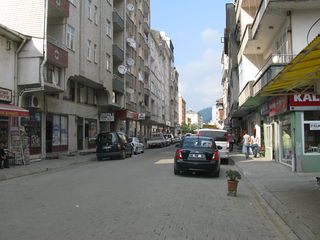
Kars Province is a province of Turkey, located in the northeastern part of the country. It shares part of its closed border with the Republic of Armenia. The provincial capital is the city of Kars. The provinces of Ardahan and Iğdır were until the 1990s part of Kars Province.

Akhaltsikhe is a small city in Georgia's southwestern region (mkhare) of Samtskhe–Javakheti. It is situated on the both banks of a small river Potskhovi, which separates the city to the old city in the north and new in the south.

Akhalkalaki is a town in Georgia's southern region of Samtskhe–Javakheti. Akhalkalaki lies on the edge of the Javakheti Plateau. The city is located about 30 kilometres (19 mi) from the border with Turkey. In 2002 over 90 percent of the city's population were ethnic Armenians. The city was passed from Ottomans to Russians after Russo-Turkish War (1828–1829). On January 4, 1900, an earthquake destroyed much of the town and killed 1,000 people in the area. As of the 2014 census the town had a population of 8,295.

Rize is the capital city of Rize Province in the eastern part of the Black Sea Region of Turkey.

The Vilayet of Erzerum was a first-level administrative division (vilayet) of the Ottoman Empire.

The Eyalet of Kars was an eyalet (province) of the Ottoman Empire. Its reported area in the 19th century was 6,212 square miles (16,090 km2).

The Eyalet of Childir or Akhalzik was an eyalet of the Ottoman Empire in the Southwestern Caucasus. The area of the former Çıldır Eyalet is now divided between Samtskhe-Javakheti and the Autonomous Republic of Adjara in Georgia and provinces of Artvin, Ardahan and Erzurum in Turkey. The administrative center was Çıldır between 1578-1628, Ahıska between 1628-1829, and Oltu between 1829-1845.

Ardahan is a city in northeastern Turkey, near the Georgian border.

Damal, formerly Petereke, is a town and district of Ardahan Province of Turkey, on the road from Kars to Posof.

Göle is a small city and surrounding district in Ardahan Province of Turkey. The city was formerly known as Merdenik, Merdinik or Ardahan-ı Küçük.

Hopa is a city and district of Artvin Province in northeast Turkey. It is located on the eastern Turkish Black Sea coast about 67 km (42 mi) from the city of Artvin and 18 kilometres from the border with Georgia.

Posof is a district of Ardahan Province of Turkey, in the far east of the country, 75 km from the city of Ardahan. It has a border crossing with neighboring Georgia at Türkgözü. Posof is well known for its handicrafts particularly its ornate silver belts and knives.

Yusufeli is a town and district of Artvin Province in the Black Sea region of Turkey. It is located on the bank of Çoruh River 104 km south-west of the city of Artvin, on the road to Erzurum.

Ninotsminda is a town and a center of the eponymous municipality located in Georgia's southern district of Samtskhe-Javakheti. According to the 2014 census the town has a population of 5,144. The vast majority of the population are Armenians.

The Eastern Anatolia Region is a geographical region of Turkey.

The Caucasus Greeks, sometimes known as the Greeks of Trans-Caucasus and Russian Asia Minor, are the historically Greek-speaking peoples of the North Caucasus and Transcaucasia in what is now southwestern Russia, Georgia, and northeastern Turkey. These specifically include the Pontic Greeks, though they today span a much wider region including the Russian north Caucasus, and the former Russian Caucasus provinces of Batum Oblast' and Kars Oblast', now in north-eastern Turkey and Adjara in Georgia.

Şeytan Castle is a castle in the Çıldır district of the Ardahan Province in Turkey.

























